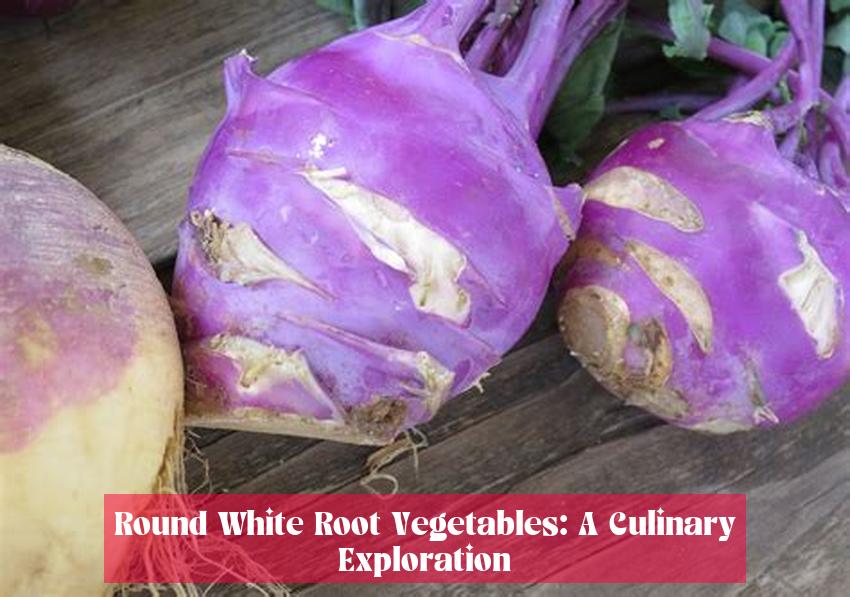Unearth the secret world of round white root vegetables with us as we embark on a culinary exploration like no other. From the feisty turnip to the giant daikon and the nutty Jerusalem artichoke, these unassuming veggies pack a flavorful punch that will leave your taste buds tingling. Join us as we peel back the layers of these versatile roots, uncovering their unique flavors and sharing tips on how to make the most of their culinary potential. Whether you’re a seasoned chef or a kitchen novice, get ready to dig deep into the world of round white root vegetables and discover a whole new realm of delicious possibilities.
Key Takeaways
- Turnips are white, round root vegetables belonging to the Brassica family, with crunchy white flesh that tastes bitter and similar to cabbage when eaten raw.
- White root vegetables include turnips, white radishes, parsnips, celeriac roots, and white sweet potatoes.
- Daikon is a long white root vegetable grown throughout East and South Asian countries, resembling an extra-large carrot and offering various consistencies and flavors when cooked.
- Jerusalem Artichoke, also known as sunchokes, are white-fleshed root vegetables with a distinctly nutty and slightly smoky taste, often eaten raw or cooked by slicing thinly, steaming, boiling, or roasting.
- Daikon radishes, native to East Asia, are lengthy white root vegetables, often referred to as winter radishes, and are a good source of fiber.
- Rutabagas are large, round, purple and white root vegetables, with a sweet, mild flavor, and are a cross between a cabbage and a turnip.
Table of Contents
Round White Root Vegetables: A Culinary Exploration

The world of culinary arts boasts a vast array of vegetables, each with its unique characteristics and flavors. Among these, round white root vegetables hold a special place, offering a symphony of tastes and textures that have captivated palates for centuries. In this comprehensive guide, we’ll delve into the diverse realm of round white root vegetables, exploring their origins, culinary versatility, and nutritional benefits.
Turnips: A Versatile Root with a Bite
Turnips, members of the Brassica family, are characterized by their round shape and white or purple skin. Their crunchy white flesh possesses a slightly bitter taste reminiscent of cabbage, making them a versatile ingredient in both raw and cooked dishes. Turnips contribute a peppery note to salads, enhance the flavor of soups and stews, and can be roasted or mashed for a hearty side dish. Additionally, turnip greens, the edible leaves of the turnip plant, are a nutrient-rich addition to salads and stir-fries.
>> Deliciously Creamy: Elevate Your Meal with White Chicken Chili with Cream Cheese
One of the most popular varieties of turnips is the Hakurei turnip, known for its mild flavor and crisp texture. These small, round turnips are often used in Asian cuisine, adding a refreshing crunch to salads and stir-fries. The larger, globe-shaped turnips, on the other hand, are ideal for roasting or mashing, their flesh becoming tender and sweet when cooked.
Turnips are not only culinary delights but also nutritional powerhouses. They are a rich source of vitamin C, an essential nutrient for immune system health. Additionally, turnips contain dietary fiber, which promotes digestive regularity and satiety, making them a valuable addition to a balanced diet.
Daikon: The Versatile Giant from the East
Originating in East and South Asia, daikon is a long, white root vegetable resembling an oversized carrot. Its name, derived from the Japanese word for “big root,” aptly describes its impressive size. Daikon is known for its versatility, offering a range of flavors and textures depending on how it is prepared. When eaten raw, daikon exhibits a crunchy texture and a mild, slightly peppery flavor. It can be grated or sliced into salads, adding a refreshing crunch and a subtle peppery note.
Cooking daikon transforms its texture and flavor, revealing its hidden culinary potential. Simmering daikon in soups and stews imparts a delicate sweetness, while roasting or grilling it brings out its caramelized notes. Daikon is also a popular ingredient in pickles and kimchi, where its ability to absorb flavors shines through.
Beyond its culinary versatility, daikon is also a nutritional powerhouse. It is an excellent source of vitamin C, potassium, and fiber, making it a valuable addition to a healthy diet. Daikon has also been traditionally used in Asian medicine for its digestive and respiratory benefits.
Jerusalem Artichoke: The Nutty Treat with a Unique Flavor
Jerusalem artichoke, also known as sunchoke, is a unique white-fleshed root vegetable with a distinctly nutty and slightly smoky flavor. Its resemblance to ginger root belies a crunchy white flesh that can be eaten raw or cooked. Slicing Jerusalem artichokes thinly and eating them raw provides a refreshing crunch and a burst of nutty flavor. Alternatively, they can be steamed, boiled, or roasted to enhance their sweetness and bring out their smoky notes.
Jerusalem artichokes are not only culinary curiosities but also nutritional gems. They are a rich source of inulin, a type of dietary fiber that promotes digestive health and may have prebiotic effects, supporting the growth of beneficial bacteria in the gut. Additionally, Jerusalem artichokes contain significant amounts of vitamin C, potassium, and iron, making them a valuable addition to a balanced diet.
More related > Rooting for Health: Unveiling the Wonders of Round Orange Root Vegetables
Conclusion
Round white root vegetables offer a diverse culinary landscape, ranging from the versatile turnip to the giant daikon and the nutty Jerusalem artichoke. Their unique flavors and textures, combined with their nutritional benefits, make them invaluable additions to any kitchen. Whether enjoyed raw, cooked, or pickled, these root vegetables add depth, flavor, and nourishment to our culinary creations.
— Wyler’s Mrs. Grass Extra Noodle Soup: A Hearty Classic for Modern Palates
So, next time you’re looking for a culinary adventure, reach for a round white root vegetable. Its unassuming appearance belies a world of flavors, textures, and nutritional benefits that are sure to delight your palate and nourish your body.
Also read Turmeric: The Golden Spice for Pregnant Women – Safety, Benefits, and Fertility
1. What root vegetable is white and round?
Turnips (Brassica rapa) are white root vegetables belonging to the Brassica family, along with cauliflower, Brussels sprouts, and broccoli. Round in shape and white or purple in color, turnips have crunchy white flesh that taste bitter and similar to cabbage when eaten raw.
2. What is the name of the white root vegetable?
White root vegetables include turnips, white radishes, parsnips, celeriac roots, and white sweet potatoes.
3. What is a long white vegetable?
Daikon is a long white root vegetable grown throughout East and South Asian countries, resembling an extra-large carrot and offering various consistencies and flavors when cooked.
4. What are the big white root vegetables with a sweet, mild flavor?
Rutabagas are large, round, purple and white root vegetables, with a sweet, mild flavor, and are a cross between a cabbage and a turnip.
5. What are some culinary uses of turnips?
Turnips contribute a peppery note to salads, enhance the flavor of soups and stews, and can be roasted or mashed for a hearty side dish. Additionally, turnip greens, the edible leaves of the turnip plant, are a nutrient-rich addition to salads and stir-fries.
6. What are the nutritional benefits of turnips?
Turnips are a rich source of vitamin C, an essential nutrient for immune system health. Additionally, turnips contain dietary fiber, which promotes digestive regularity and satiety, making them a valuable addition to a balanced diet.
7. What are some popular varieties of turnips?
One of the most popular varieties of turnips is the Hakurei turnip, known for its mild flavor and crisp texture. These small, round turnips are often used in Asian cuisine, adding a refreshing crunch to salads and stir-fries. The larger, globe-shaped turnips, on the other hand, are ideal for roasting or mashing, their flesh becoming tender and sweet when cooked.















